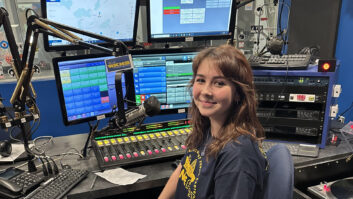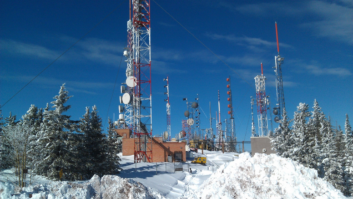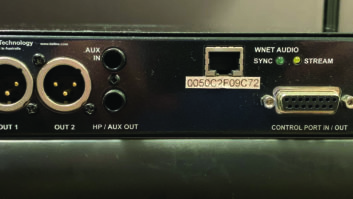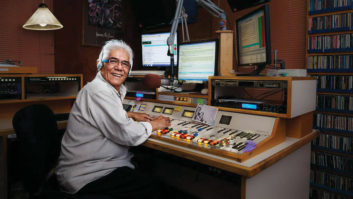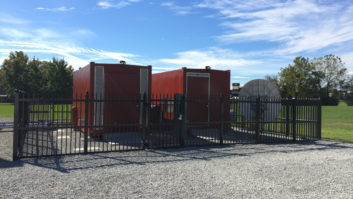
As part of our ebook “Trends in Audio Processing for Radio,” we asked veteran engineer and consultant Gary Kline to create a list of key topics to consider.
I think the processor may be one of the most discussed pieces of equipment that a station owns. Everyone you meet in any country will be glad to give you their opinion on which is the best for a particular market, format or budget. If you put 10 PDs or engineers in a room, it would be rare that they agree on the “best processor out there.”
That said, there are points most processing gurus will agree on. Here are some based on my travels and experience.
1 – Know the market, know your competitors. Get to know everything you can about your competitors and their technical setup.
This goes beyond listening to every station on the dial carefully (you should), but also objectively. Don’t be reluctant to admit that another station sounds — in your opinion — better than yours. Do your research, which may require intelligence gathering. Get to know everyone’s transmission path including console, STL, transmitter, age of equipment, and, of course, the processing they use. Don’t forget to listen to HD or DAB channels too.
You should know your equipment; once you know what the competition is using, you can balance your objectiveness.
For example, say you think the CHR competitor sounds better than you. Is that because they have a cleaner transmission path? Stronger/newer processing? Better source material? Greater RF over the coverage area? If any of those is true, your processing concerns may expand to fixing other things too.
Whether you have a direct competitor in the market or not, still get to know each station’s particular sound. This will help you rate the market overall and help you in designing your custom audio signature sound. Some markets are softer. Some are loud and very competitive with high MPX density levels. Some just sound poor across the dial.
[Related: “How to Pick an On-Air Processor”]
2 – Know your goals. Too often there is a desire to purchase a new processor without a clear reason. Understanding your reasons and budget constraints will go a long way in making an informed choice.
Is your processor older and not as competitive or clean-sounding? Do you need to feed a new DAB or HD channel, and your processor does not support that? Did your current unit die of old age or a lightning strike? Is it time to standardize processing or stereo generators across the network? Are ratings slipping That’s a common reason given, but a processor is not always a ratings cure.
What’s the budget? How much processing can you afford? Or better yet, do you need to buy the top-level box when something less costly might do?
I frequently get into a discussion about goals and budget with an operator only to find out that what they already have meets their goals; in other cases, I may determine that while an operator thought they could make do with what they already own, it becomes clear they cannot. Each situation is unique.
3 – Know the landscape of current products. If you are going to make a purchasing decision you should know what your choices are.
Sure, most of us in the radio business know the top brands and may even know the current model(s). But do you know about processors designed, manufactured and sold around the world? Processing philosophies and design various around the world; perhaps there is a “sound” you can import that your listeners will gravitate to.
Do you know how each brand sounds or the benefit of one versus another? Do you know “street price” for every model? Do you know which features require an additional fee for extra outputs like one for HD or an internet stream? Do you know if there are forthcoming firmware updates which may add improvements which could influence your decision? Do you have contacts at the manufacturer or their reps who can explain these things or set up a demo?
4 – Consider hiring a seasoned audio expert if you are not comfortable designing your audio signature.
I visit broadcast facilities that have PDs or engineers who are adept at processing and know how to install and tune a box. I also run into places where outside expertise can add considerable value.
There are many important and critical steps in setting up a new processor. There are the technical transmission settings such as input, output, pilot injection, sample rates, input switching, network IP parameters, and other interfaces. Then there are the hundreds (yes, hundreds) of individual processing settings to tailor the audio to your preferences.
Even in situations where a station has in-house processing expertise, it can help to get an objective opinion from individual who has a toolkit of presets and starting points to speed the adjustment process. It is also good insurance to have a consultant to ensure the transmission parameters are set correctly and legally.
Many newer processors have non-expert modes that make the tailoring of the sound easier with fewer settings. However, in some instances, such as very competitive situations, “expert” mode may be the best way to achieve that perfect signature sound.
A consultant can help with the selection process as well as performing a full technical review of the plant.
5 – Understand the feature sets of modern processing. Local stations may need one set of features while network, enterprise or state-owned broadcasters may require a different set. Here’s a series of questions you might consider, and topics to research.
Do you know what MPX over IP is? (Hint, it is one the latest techniques for sending your composite MPX over IP to your transmitter.) Do you know who offers that and in what configuration(s)?
Do you know what composite EQ is? What is pilot protection? What is SSB and DSB and why might that matter to you?
How many digital and analog inputs and outputs do you need? Which boxes offer how many of each?
Do you want a box that can generate dynamic RDS? How many bands of AGC and limiting would work best for your format and desired sound?
Do you want dual power supplies or some form of additional redundancy? Are you interested in processors that can run in a virtual environment and is that something you should be interested in?
Do you need GPS sync for your stereo generator, say for an SFN? Did you know that many processors sold today have hard-drive storage to hold music and imaging so that if your studio playout system (or studio altogether) goes offline, you’ll still be on the air?
Do you need SNMP monitoring? Do you know what de-clipping is? Phase correction? Do you want to feed your analog transmitter, digital transmitter and internet stream simultaneously? Do you need ratings encoding or a ratings encoder patch-point?
I could fill pages with features you might consider. Do your research and get to know what features matter and why they matter, then overlay that with your market research.
6 – Know your air chain. Understand you air chain from microphone to speaker. Literally.
I visit many stations whose managers complain about their sound and ask for processing adjustments or a processor to “fix” it. I almost always find weak links in their audio path that contribute to the quality issue.
Sure, they may need a new processor. Sure, they may need careful adjusting and tweaking. However, other things need to be addressed too. At the top of the list and most often is source material.
I still find plenty of MP3s on the playout system hard drive. I’ve been to stations with hundreds of MP3s (with bit rates between 96 and 192) and they wonder why their sound is not as clean or lush as the other stations in the market. I very rarely find a hard drive that doesn’t have at least a few MP3s.
Beware — several playout systems rename MP3 to WAV and increase the file size; that will fake you out. You need special tools to scan the library and find these fake files. More on source material below.
I also see STL paths that have issues. Does your feed to the transmitter use an uncompressed audio path or is it something lossy? Is your sample rate 44.1 kHz or 32 kHz? How many A/D and D/A conversions are in the path?
Also I still find digital consoles that use their analog output to feed a digital STL. I see playout systems using their analog outputs to feed a digital console. Even with AoIP systems — which you’d think by definition would be all-digital — it is possible to find analog ins/outs used for playout systems, emergency alerting interrupt boxes and feeds to the transmitter.
Each analog to digital conversion (or the other way around) is another point of degradation. These weak points between console and transmitter add up; while one thing alone might not be noticeable, several together can be.
The road to excellent sound is not just about the box, it’s about the entire system.
7 – Be a perfectionist on source material every step of the way. You know this saying but it certainly applies to processing: Garbage In = Garbage Out.
In over 90% of stations I visit, I find at least several source material violations: MP3s, low sample rates, recordings from imperfect masters, etc. This is what I tell every PD, MD, and APD I meet.
We all know MP3s are a no-no. Resist the urge to download material from YouTube or iTunes or some other source.
I often hear that a particular MP3 files is the result of not knowing where to find the older material. There are sources for CD quality (or better) versions of almost anything — many are online for download. There are companies that can provide a fully loaded hard drive with your specific music and in true PCM WAV uncompressed format. Do your research, put the effort in, and ensure you have the best material.
Sometimes the issue isn’t the file format but the actual source. There are plenty of forums online that discuss the best masters, greatest hit collections and top picks by audiophiles for various artists. Google is your friend.
Did you know that among several discs by ABBA, some are considered far better quality than others? Read this interesting discussion.
Use your ears. If you hear a song on your station that doesn’t sound quite right, go back and research the cut. If you can’t determine where it came from, get a copy of known quality.
If you run HD or DAB, you already know those digital signals use a codec. If you play an MP3 file — which already is a lossy format — over an HD/DAB channel, you end up with cascading codecs. In other words, the sound quality may even be worse when listened on the digital carrier.
8 – Don’t rush things. It takes time to perfect an audio signature. It can take days or weeks to get that perfect audio signature. Take your time.
Some of the best sounding stations around the world have taken their time to “dial in” their settings. It is rare to design a sophisticated, nuanced and consistent sound in one day.
Yes, processors come with presets that get you in the ballpark. And, yes, as a result you can have a decent sounding station quickly, assuming you don’t have other severe audio chain problems, very poor source material, etc. But, for that perfect market-leading sound, it takes time to “process beyond the preset.”
For example after a processor is adjusted, all parties should take a break, sleep and then listen again. Your ears get fatigued after hours of listening and adjusting. They can confuse you. Sleep on it and see how things sound when your ears are fresh. In some cases, as you get closer, it’s helpful to wait a week or two and listen afresh. The longer period also allows you to listen to various content samples to ensure that the sound is consistent across sources.
If you are an oldies or 80s station or play music across several decades, finding a balanced sound that works for every cut can be challenging. The way music was mastered and produced in the 1970s is different from how it was done in the 80s and way different then say, Dua Lipa in 2020.
And, yes, there are stations that play Madonna, Van Halen and Dua Lipa in the same hour. I worked on one recently and it required careful attention to detail to sound consistent throughout the day.
Fortunately, many of the modern processors have great toolsets to help with this issue.
9 – Understand the politics. The process of processing can be complicated by the need for more than one person to agree on the results.
You may be working alongside a PD, OM, GM, programming consultant or owner who “thinks” they know audio. And perhaps they do— but will they all agree on what good sound is? Chances are, no.
Audio processing is very subjective. What one person thinks is the perfect low-end or vocal mix might sound horrible to another.
If you are the person with fingers on the knobs, your bedside manner and maturity will become crucial in these situations.
Don’t be offended if someone says they don’t like the sound. Don’t be frustrated if it takes several iterations to get consensus. And you may never get 100% agreement.
To avoid problems I’ll ask, at the beginning, to know who makes the final call. It may be the PD of the brand or the PD plus the general manager. Sometimes, it’s the owner too. Try to limit decision-making team to very few people.
I’ve been asked as a processing consultant to be the one to make the final call. I inquire about the goals; for example, maybe everyone thinks the high-end needs to be cranked yet they’ve also said that TSL matters. In a situation like that, I may advise that too much high-end could risk tuneout and lower TSL.
10 – Listen to your product on several devices and in various types of vehicles. Listen in your car, your GM’s car, your PD’s car and your best friends’ cars. Listen on a clock radio (especially in mono), on different smart speakers, and through the type of headphones/earbuds typically worn by your listeners.
Your signature will sound different depending on where and what you are listening to. Ensure that the sound is acceptable across most devices and speakers. It’s OK to tweak based on what you hear. The goal is a nice balance so that the station sounds great on small speakers and big ones alike.
Be honest with yourself. You may have achieved what you think is the best low-end you’ve ever heard … in your car. Then, you listen in another car and wonder why it’s overwhelming. Don’t ignore it, go back and carefully find the right balance.
Remember the politics. The PD may be listening in their car and will legitimately hear things differently than you do. The audience will too. This is another reason finding that perfect sound takes time.
That being said, you can chase your tail forever if you make an adjustment every time you receive a comment or listen to a new device; know when to stop. Keeping the decision team small will help with this.
11 – Don’t forget your digital assets. These include your streams, Alexa, YouTube, FB, IG, etc. There are smart speakers, mobile apps and other ways in which your product is distributed.
Do you process your stream with as much thought and attention to detail as your terrestrial signal? About half of the stations I listen to online are not paying attention to their digital asset audio processing.
Consider using your main processor if that’s technically feasible. If not, use a separately purchased processor designed for digital streaming, an older model laying around the station left over from a previous upgrade (something is better than nothing), or one of the many great software-based processors you can find online.
Some manufacturers do offer software that can be used for streaming; many will run on the same PC your streaming encoder resides on. There are also hardware-based streaming appliances with built-in processing.
But don’t forget, processing for streaming requires a sound that’s great across various devices.
Digital processing design does not have all the same considerations as AM or FM transmission. For instance, analog FM is limited to 15 kHz frequency response while your stream might go out to 20 kHz. There is no 50us or 75us equalization curve.
Pay attention to your bit rates — don’t dip too low. There are several very good white papers on streaming across the web and located on the sites of audio processing manufacturers.
Streaming audio, done properly, will sound amazing — better than the analog terrestrial signal.
The author is owner of Kline Consulting Group LLC. He has held technical positions with several major broadcast organizations, most notably as senior VP of engineering at Cumulus Media. He has provided engineering support and consulting in the United States, Canada, China and several South American countries. He is a past recipient of the Radio World Excellence in Engineering Award.

